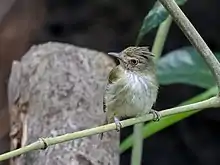Helmeted pygmy tyrant
The helmeted pygmy tyrant (Lophotriccus galeatus) is a species of bird in the family Tyrannidae.[2] It is found in Brazil, Colombia, French Guiana, Guyana, Peru, Suriname, and Venezuela. Its natural habitats are subtropical or tropical moist lowland forests and heavily degraded former forest.[3]
| Helmeted pygmy tyrant | |
|---|---|
 | |
| Scientific classification | |
| Kingdom: | Animalia |
| Phylum: | Chordata |
| Class: | Aves |
| Order: | Passeriformes |
| Family: | Tyrannidae |
| Genus: | Lophotriccus |
| Species: | L. galeatus |
| Binomial name | |
| Lophotriccus galeatus (Boddaert, 1783) | |
Taxonomy
The helmeted pygmy tyrant was described by the French polymath Georges-Louis Leclerc, Comte de Buffon in 1780 in his Histoire Naturelle des Oiseaux from a sample collected in Cayenne, French Guiana.[4] The bird was also illustrated in a hand-coloured plate engraved by François-Nicolas Martinet in the Planches Enluminées D'Histoire Naturelle which was produced under the supervision of Edme-Louis Daubenton to accompany Buffon's text.[5] Neither the plate caption nor Buffon's description included a scientific name but in 1783 the Dutch naturalist Pieter Boddaert coined the binomial name Montacilla galeata in his catalogue of the Planches Enluminées.[6] The helmeted pygmy tyrant is now placed in the genus Lophotriccus that was introduced by the German ornithologist Hans von Berlepsch in 1883.[7] The species is monotypic.[8] The genus name combines the Ancient Greek lophos meaning "crest" with trikkos which is an unidentified small bird. In ornithology triccus is used to denote a tyrant flycatcher. The specific name galeatus is Latin for "helmeted".[9]
References
- BirdLife International (2012). "Lophotriccus galeatus". IUCN Red List of Threatened Species. 2012. Retrieved 26 November 2013.
- "Helmeted Pygmy-tyrant (Lophotriccus galeatus)". Handbook of Birds of the World Alive. Lynx Edicions. Retrieved 20 August 2018.
- "Helmeted Pygmy-Tyrant - Introduction". Neotropical Birds Online. Cornell Lab of Ornithology. Retrieved 20 August 2018.
- Buffon, Georges-Louis Leclerc de (1780). "Le figuier huppé". Histoire Naturelle des Oiseaux (in French). Volume 9. Paris: De L'Imprimerie Royale. p. 462.
- Buffon, Georges-Louis Leclerc de; Martinet, François-Nicolas; Daubenton, Edme-Louis; Daubenton, Louis-Jean-Marie (1765–1783). "Figuier hupé, de Cayenne". Planches Enluminées D'Histoire Naturelle. Volume 4. Paris: De L'Imprimerie Royale. Plate 391 Fig. 1.
- Boddaert, Pieter (1783). Table des planches enluminéez d'histoire naturelle de M. D'Aubenton : avec les denominations de M.M. de Buffon, Brisson, Edwards, Linnaeus et Latham, precedé d'une notice des principaux ouvrages zoologiques enluminés (in French). Utrecht. p. 24, Number 391 Fig. 1.
- Berlepsch, Hans von (1883). "Liste des oiseaux recueillis par MM. Stolzmann et Siemiradzki dans l'Ecuadeur occidental". Proceedings of the Zoological Society of London (in French): 536–577 [553]. The volume has 1883 on the title page but the issue was not published until 1884.
- Gill, Frank; Donsker, David, eds. (2019). "Tyrant flycatchers". World Bird List Version 9.2. International Ornithologists' Union. Retrieved 16 August 2019.
- Jobling, James A. (2010). The Helm Dictionary of Scientific Bird Names. London: Christopher Helm. pp. 169, 232. ISBN 978-1-4081-2501-4.
